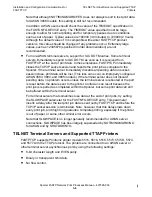
Installing and Configuring FASTP Network Print
Processes
Spooler FASTP Network Print Processes Manual — 427528-006
2 - 42
Error-Handling Considerations
If a processor fails, the Spooler supervisor only restarts the process (and any failed
jobs) automatically if the Spooler
RESTART
parameter was specified as non-zero
for the devices controlled by the FASTP network print process. In this case, the
Spooler supervisor does not wait for the
RESTART
interval to elapse.
Most FASTP network print processes report other unexpected errors in text form to
$0. Beginning with the G06.10 and D48.02 RVUs of FASTPTCP, FASTPTCP
generates tokenized event messages on the $0 collector. (Note: as a temporary
measure to allow users time to adjust their EMS filters, the ASCII 512 text
messages can be written instead by setting bit 15 (%1) in the Spoolcom PRINT
PARM command.) For descriptions of all the messages generated by the FASTP
network print processes, including the FASTPTCP event messages, see
Appendix B, EMS Messages
.
Beginning with the G06.10 and D48.02 RVUs, you can also enable debugging
features, disable event messages, and generate detailed EMS events for
FASTPTCP by setting bit 1 (%40000) and bit 14 (%2) in the Spoolcom PRINT
PARM command. For details, see
PRINT PARM Attribute
on page 3-10.
Errors that indicate an internal-logic error cause the FASTP network print process
to abend. Unless the SAVEABEND option has been disabled in the BIND, an
abend always creates a SAVEABEND file. SAVEABEND dumps generally indicate
a serious problem and should be forwarded to your service provider for analysis.






























